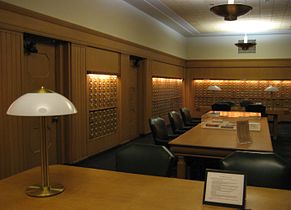Works Progress Administration
 | |
| Agency overview | |
|---|---|
| Formed | May 6, 1935 (1935-05-06) |
| Preceding |
|
| Dissolved | June 30, 1943 |
| Employees | 8.5 million 1935–1943 3.3 million in November 1938 (peak) |
| Annual budget | $1.3 billion (1935) |
| Key document |
|
The Works Progress Administration (WPA; renamed in 1939 as the Work Projects Administration) was the largest and most ambitious American New Deal agency, employing millions of people (mostly unskilled men) to carry out public works projects,[1] including the construction of public buildings and roads. In a much smaller project, Federal Project Number One, the WPA employed musicians, artists, writers, actors and directors in large arts, drama, media, and literacy projects.[1]
Almost every community in the United States had a new park, bridge, or school that was constructed by the agency. The WPA's initial appropriation in 1935 was for $4.9 billion (about 6.7 percent of the 1935 GDP).[2]
Headed by Harry Hopkins, the WPA provided jobs and income to the unemployed during the Great Depression in the United States, while developing infrastructure to support the current and future society. At its peak in 1938, it provided paid jobs for three million unemployed men and women, as well as youth in a separate division, the National Youth Administration. Between 1935 and 1943, when the agency was disbanded, the WPA employed 8.5 million people.[3] Most people who needed a job were eligible for employment in some capacity.[4] Hourly wages were typically set to the prevailing wages in each area.[5]:70 Full employment, which was reached in 1942 and emerged as a long-term national goal around 1944, was not the goal of the WPA; rather, it tried to provide one paid job for all families in which the breadwinner suffered long-term unemployment.[6]:64, 184
"The stated goal of public building programs was to end the depression or, at least, alleviate its worst effects," sociologist Robert D. Leighninger asserted. "Millions of people needed subsistence incomes. Work relief was preferred over public assistance (the dole) because it maintained self-respect, reinforced the work ethic, and kept skills sharp."[7]:228
The WPA was a national program that operated its own projects in cooperation with state and local governments, which provided 10–30% of the costs. Usually the local sponsor provided land and often trucks and supplies, with the WPA responsible for wages (and for the salaries of supervisors, who were not on relief). WPA sometimes took over state and local relief programs that had originated in the Reconstruction Finance Corporation (RFC) or Federal Emergency Relief Administration programs (FERA).[6]:63
It was liquidated on June 30, 1943, as a result of low unemployment due to the worker shortage of World War II. The WPA had provided millions of Americans with jobs for eight years.[6]:71
Contents
1 Establishment
2 Employment
3 Projects
3.1 Federal Project Number One
3.1.1 Federal Art Project
3.1.2 Federal Music Project
3.1.3 Federal Theatre Project
3.1.4 Federal Writers' Project
3.1.5 Historical Records Survey
4 Relief for African Americans
5 Women
6 Criticism
7 Evolution
8 Termination
9 Legacy
10 See also
11 References
12 Further reading
13 External links
Establishment
@media all and (max-width:720px).mw-parser-output .tmulti>.thumbinnerwidth:100%!important;max-width:none!important.mw-parser-output .tmulti .tsinglefloat:none!important;max-width:none!important;width:100%!important;text-align:center


FERA administrator and WPA head Harry Hopkins speaking to reporters (November 1935)
A joint resolution introduced January 21, 1935,[8] the Emergency Relief Appropriation Act of 1935 was passed by the United States Congress and signed into law by President Franklin D. Roosevelt on April 8, 1935.[9] On May 6, 1935, FDR issued Executive Order 7034, establishing the Works Progress Administration.[10][11] The WPA superseded the work of the Federal Emergency Relief Administration, which was dissolved. Direct relief assistance was permanently replaced by a national work relief program—a major public works program directed by the WPA.[12]
The WPA was largely shaped by Harry Hopkins, supervisor of the Federal Emergency Relief Administration and close adviser to Roosevelt. Both Roosevelt and Hopkins believed that the route to economic recovery and the lessened importance of the dole would be in employment programs such as the WPA.[6]:56–57Hallie Flanagan, national director of the Federal Theatre Project, wrote that "for the first time in the relief experiments of this country the preservation of the skill of the worker, and hence the preservation of his self-respect, became important."[13]:17
The WPA was organized into the following divisions:
- The Division of Engineering and Construction, which planned and supervised construction projects including airports, dams, highways and sanitation systems.[14]
- The Division of Professional and Service Projects (called the Division of Women's and Professional Projects in 1937), which was responsible for white-collar projects including education programs, recreation programs, and the arts projects. It was later named the Division of Community Service Programs and the Service Division.[15]
- The Division of Finance.[16]
- The Division of Information.[17]
- The Division of Investigation, which succeeded a comparable division at FERA and investigated fraud, misappropriation of funds and disloyalty.[18]
- The Division of Statistics, also known as the Division of Social Research.[19]
- The Project Control Division, which processed project applications.[20]
- Other divisions including the Employment, Management, Safety, Supply, and Training and Reemployment.[21]
Employment

WPA road development project
.mw-parser-output .templatequoteoverflow:hidden;margin:1em 0;padding:0 40px.mw-parser-output .templatequote .templatequoteciteline-height:1.5em;text-align:left;padding-left:1.6em;margin-top:0
These ordinary men and women proved to be extraordinary beyond all expectation. They were golden threads woven in the national fabric. In this, they shamed the political philosophy that discounted their value and rewarded the one that placed its faith in them, thus fulfilling the founding vision of a government by and for its people. All its people.
— Nick Taylor, American-Made: The Enduring Legacy of the WPA[22]:530
The goal of the WPA was to employ most of the unemployed people on relief until the economy recovered. Harry Hopkins testified to Congress in January 1935 why he set the number at 3.5 million, using Federal Emergency Relief Administration data. Estimating costs at $1,200 per worker per year ($21.5 thousand in present-day terms[23]), he asked for and received $4 billion ($71.5 billion in present-day terms[23]). Many women were employed, but they were few compared to men.
In 1935 there were 20 million people on relief in the United States. Of these, 8.3 million were children under 16 years of age; 3.8 million were persons between the ages of 16 and 65 who were not working or seeking work. These included housewives, students in school, and incapacitated persons. Another 750,000 were person age 65 or over.[24]:562 Thus, of the total of 20 million persons then receiving relief, 13 million were not considered eligible for employment. This left a total of 7 million presumably employable persons between the ages of 16 and 65 inclusive. Of these, however, 1.65 million were said to be farm operators or persons who had some non-relief employment, while another 350,000 were, despite the fact that they were already employed or seeking work, considered incapacitated. Deducting this 2 million from the total of 7.15 million, there remained 5.15 million persons age 16 to 65, unemployed, looking for work, and able to work.[24]:562

FDR and Hopkins (September 1938)
Because of the assumption that only one worker per family would be permitted to work under the proposed program, this total of 5.15 million was further reduced by 1.6 million—the estimated number of workers who were members of families with two or more employable people. Thus, there remained a net total of 3.55 million workers in as many households for whom jobs were to be provided.[24]:562
The WPA reached its peak employment of 3,334,594 people in November 1938.[22]:547 To be eligible for WPA employment, an individual had to be an American citizen, 18 or older, able-bodied, unemployed, and certified as in need by a local public relief agency approved by the WPA. The WPA Division of Employment selected the worker's placement to WPA projects based on previous experience or training. Worker pay was based on three factors: the region of the country, the degree of urbanization, and the individual's skill. It varied from $19 per month to $94 per month, with the average wage being about $52.50—$914.00 in present-day terms.[23][25] The goal was to pay the local prevailing wage, but limit the hours of work to 8 hours a day or 40 hours a week; the stated minimum being 30 hours a week, or 120 hours a month.[24]:213
Projects



WPA projects were administered by the Division of Engineering and Construction and the Division of Professional and Service Projects. Most projects were initiated, planned and sponsored by states, counties or cities. Nationwide projects were sponsored until 1939.[26]
The WPA built traditional infrastructure of the New Deal such as roads, bridges, schools, courthouses, hospitals, sidewalks, waterworks, and post-offices, but also constructed museums, swimming pools, parks, community centers, playgrounds, coliseums, markets, fairgrounds, tennis courts, zoos, botanical gardens, auditoriums, waterfronts, city halls, gyms, and university unions. Most of these are still in use today.[7]:226 The amount of infrastructure projects of the WPA included 40,000 new and 85,000 improved buildings. These new buildings included 5,900 new schools; 9,300 new auditoriums, gyms, and recreational buildings; 1,000 new libraries; 7,000 new dormitories; and 900 new armories. In addition, infrastructure projects included 2,302 stadiums, grandstands, and bleachers; 52 fairgrounds and rodeo grounds; 1,686 parks covering 75,152 acres; 3,185 playgrounds; 3,026 athletic fields; 805 swimming pools; 1,817 handball courts; 10,070 tennis courts; 2,261 horseshoe pits; 1,101 ice-skating areas; 138 outdoor theatres; 254 golf courses; and 65 ski jumps.[7]:227 Total expenditures on WPA projects through June 1941 totaled approximately $11.4 billion—the equivalent of $190 billion today.[23] Over $4 billion was spent on highway, road, and street projects; more than $1 billion on public buildings, including the iconic Dock Street Theatre in Charleston, the Griffith Observatory in Los Angeles, and Timberline Lodge in Oregon's Mount Hood National Forest.[27]:252–253
More than $1 billion—$16.7 billion today[23]—was spent on publicly owned or operated utilities; and another $1 billion on welfare projects, including sewing projects for women, the distribution of surplus commodities, and school lunch projects.[24]:129 One construction project was the Merritt Parkway in Connecticut, the bridges of which were each designed as architecturally unique.[28] In its eight-year run, the WPA built 325 firehouses and renovated 2,384 of them across the United States. The 20,000 miles of water mains, installed by their hand as well, contributed to increased fire protection across the country.[6]:69
The direct focus of the WPA projects changed with need. In 1935 priority projects were to improve infrastructure; roads, extension of electricity to rural areas, water conservation, sanitation and flood control. In 1936, as outlined in that year's Emergency Relief Appropriations Act, public facilities became a focus; parks and associated facilities, public buildings, utilities, airports, and transportation projects were funded. The following year, saw the introduction of agricultural improvements, such as the production of marl fertilizer and the eradication of fungus pests. As the Second World War approached, and then eventually began, WPA projects became increasingly defense related.[6]:70
One project of the WPA was funding state-level library service demonstration projects, to create new areas of library service to underserved populations and to extend rural service.[29] Another project was the Household Service Demonstration Project, which trained 30,000 women for domestic employment. South Carolina had one of the larger statewide library service demonstration projects. At the end of the project in 1943, South Carolina had twelve publicly funded county libraries, one regional library, and a funded state library agency.[30]
Federal Project Number One
A significant aspect of the Works Progress Administration was the Federal Project Number One, which had five different parts: the Federal Art Project, the Federal Music Project, the Federal Theatre Project, the Federal Writers Project, and the Historical Records Survey. The government wanted to provide new federal cultural support instead of just providing direct grants to private institutions. After only one year, over 40,000 artists and other talented workers had been employed through this project in the United States.[31] Cedric Larson stated that "The impact made by the five major cultural projects of the WPA upon the national consciousness is probably greater in toto than anyone readily realizes. As channels of communication between the administration and the country at large, both directly and indirectly, the importance of these projects cannot be overestimated, for they all carry a tremendous appeal to the eye, the ear, or the intellect—or all three."[32]:491
Federal Art Project
This project was directed by Holger Cahill, and in 1936 employment peaked at over 5,300 artists. The Arts Service Division created illustrations and posters for the WPA writers, musicians, and theaters. The Exhibition Division had public exhibitions of artwork from the WPA, and artists from the Art Teaching Division were employed in settlement houses and community centers to give classes to an estimated 50,000 children and adults. They set up over 100 art centers around the country that served an estimated eight million individuals.[31]
Federal Music Project

Noon-hour WPA band concert in Lafayette Square, New Orleans (1940)
Directed by Nikolai Sokoloff, former principal conductor of the Cleveland Orchestra, the Federal Music Project employed over 16,000 musicians at its peak. Its purpose was to establish different ensembles such as chamber groups, orchestras, choral units, opera units, concert bands, military bands, dance bands, and theater orchestras that gave an estimated 131,000 performances and programs to 92 million people each week.[31] The Federal Music Project performed plays and dances, as well as radio dramas.[32]:494 In addition, the Federal Music Project gave music classes to an estimated 132,000 children and adults every week, recorded folk music, served as copyists, arrangers, and librarians to expand the availability of music, and experimented in music therapy.[31] Sokoloff stated, "Music can serve no useful purpose unless it is heard, but these totals on the listeners' side are more eloquent than statistics as they show that in this country there is a great hunger and eagerness for music."[32]:494
Federal Theatre Project
This project was directed by Iowan Hallie Flanagan, and employed 12,700 performers at its peak. These performers presented more than 1,000 performances each month to almost one million people, produced 1,200 plays in the four years it was established, and introduced 100 new playwrights. Many performers later became successful in Hollywood including Orson Welles, John Houseman, Burt Lancaster, Joseph Cotten, Canada Lee, Will Geer, Joseph Losey, Virgil Thomson, Nicholas Ray, E.G. Marshall and Sidney Lumet. The Federal Theatre Project was the first project to end in June 1939 after four years from an end of funding from the federal government.[31]
Federal Writers' Project
This project was directed by Henry Alsberg and employed 6,686 writers at its peak in 1936.[31] By January 1939, more than 275 major books and booklets had been published by the FWP.[32]:494 Most famously, the FWP created the American Guide Series, which produced thorough guidebooks for every state that include descriptions of towns, waterways, historic sites, oral histories, photographs, and artwork.[31] An association or group that put up the cost of publication sponsored each book, the cost was anywhere from $5,000 to $10,000. In almost all cases, the book sales were able to reimburse their sponsors.[32]:494 Additionally, another important part of this project was to record oral histories to create archives such as the Slave Narratives and collections of folklore. These writers also participated in research and editorial services to other government agencies.[31]
Historical Records Survey
This project was the smallest of Federal Project Number One and served to identify, collect, and conserve United States' historical records.[31] It is one of the biggest bibliographical efforts and was directed by Dr. Luther H. Evans. At its peak, this project employed more than 4,400 workers.[32]:494

1940 WPA poster using Little Miss Muffet to promote reading among children.
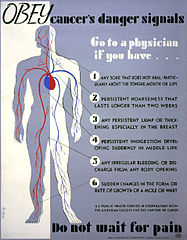
WPA health education poster about cancer, c. 1936–1938

Poster for the WPA shows various items that can be purchased at the 5 & 10¢ store

WPA poster advertising art classes for children
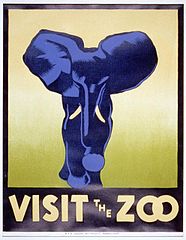
WPA poster promoting the zoo as a place to visit, showing an elephant
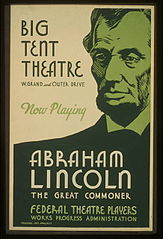
1936 WPA Poster for Federal Theatre Project presentation

WPA poster encouraging laborers to work for America
Relief for African Americans
The share of Federal Emergency Relief Administration and WPA benefits for African Americans exceeded their proportion of the general population. The FERA's first relief census reported that more than two million African Americans were on relief during early 1933, a proportion of the African-American population (17.8%) that was nearly double the proportion of whites on relief (9.5%).[33] This was during the period of Jim Crow and racial segregation in the South, when blacks were largely disenfranchised.
By 1935, there were 3,500,000 African Americans (men, women and children) on relief, almost 35 percent of the African-American population; plus another 250,000 African-American adults were working on WPA projects. Altogether during 1938, about 45 percent of the nation's African-American families were either on relief or were employed by the WPA.[33]
Civil rights leaders initially objected that African Americans were proportionally underrepresented. African American leaders made such a claim with respect to WPA hires in New Jersey, stating, "In spite of the fact that Blacks indubitably constitute more than 20 percent of the State's unemployed, they composed 15.9% of those assigned to W.P.A. jobs during 1937."[24]:287 Nationwide in 1940, 9.8% of the population were African American.
However, by 1941, the perception of discrimination against African Americans had changed to the point that the NAACP magazine Opportunity hailed the WPA:
It is to the eternal credit of the administrative officers of the WPA that discrimination on various projects because of race has been kept to a minimum and that in almost every community Negroes have been given a chance to participate in the work program. In the South, as might have been expected, this participation has been limited, and differential wages on the basis of race have been more or less effectively established; but in the northern communities, particularly in the urban centers, the Negro has been afforded his first real opportunity for employment in white-collar occupations.[24]:295
The WPA mostly operated segregated units, as did its youth affiliate, the National Youth Administration.[34] Blacks were hired by the WPA as supervisors in the North; however of 10,000 WPA supervisors in the South, only 11 were black.[35] Historian Anthony Badger argues, "New Deal programs in the South routinely discriminated against blacks and perpetuated segregation."[36]
Women

Hispanic women in Costilla, New Mexico, weaving rag rugs in 1939.
About 15% of the household heads on relief were women, and youth programs were operated separately by the National Youth Administration. The average worker was about 40 years old (about the same as the average family head on relief).
WPA policies were consistent with the strong belief of the time that husbands and wives should not both be working (because the second person working would take one job away from some other breadwinner). A study of 2,000 female workers in Philadelphia showed that 90% were married, but wives were reported as living with their husbands in only 18 percent of the cases. Only 2 percent of the husbands had private employment. Of the 2,000 women, all were responsible for one to five additional people in the household.[24]:283
In rural Missouri, 60% of the WPA-employed women were without husbands (12% were single; 25% widowed; and 23% divorced, separated or deserted). Thus, only 40% were married and living with their husbands, but 59% of the husbands were permanently disabled, 17% were temporarily disabled, 13% were too old to work, and remaining 10% were either unemployed or handicapped. Most of the women worked with sewing projects, where they were taught to use sewing machines and made clothing and bedding, as well as supplies for hospitals, orphanages, and adoption centers.[24]:283[37]
One WPA-funded project, the Pack Horse Library Project, mainly employed women to deliver books to rural areas in eastern Kentucky.[38] Many of the women employed by the project were the sole breadwinners for their families.[39]
Criticism

Poster representing the WPA defending itself from attacks
The WPA had numerous critics, especially from conservatives. The strongest attacks were that it was the prelude for a national political machine on behalf of Roosevelt. Reformers secured the Hatch Act of 1939 that largely depoliticized the WPA.[40]
Others complained that far left elements played a major role, especially in the New York City unit. Representative J. Parnell Thomas of the House Committee on Un-American Activities claimed in 1938 that divisions of the WPA were a "hotbed of Communists" and "one more link in the vast and unparalleled New Deal propaganda network."[41]
Much of the criticism of the distribution of projects and funding allotment is a result of the view that the decisions were politically motivated. The South, as the poorest region of the United States, received 75 percent less in federal relief and public works funds per capita than the West. Critics would point to the fact that Roosevelt's Democrats could be sure of voting support from the South, whereas the West was less of a sure thing; swing states took priority over the other states.[5]:70
There was a perception that WPA employees were not diligent workers, and that they had little incentive to give up their busy work in favor of productive jobs. Some employers said that the WPA instilled poor work habits and encouraged inefficiency.[42] Some job applicants found that a WPA work history was viewed negatively by employers, who said they had formed poor work habits.[43]
A Senate committee reported that, "To some extent the complaint that WPA workers do poor work is not without foundation. … Poor work habits and incorrect techniques are not remedied. Occasionally a supervisor or a foreman demands good work."[44] The WPA and its workers were ridiculed as being lazy. The organization's initials were said to stand for "We Poke Along" or "We Putter Along" or "We piddle around" or "Whistle, Piss and Argue." These were sarcastic references to WPA projects that sometimes slowed down deliberately because foremen had an incentive to keep going, rather than finish a project.[45]
The WPA's Division of Investigation proved so effective in preventing political corruption "that a later congressional investigation couldn't find a single serious irregularity it had overlooked," wrote economist Paul Krugman. "This dedication to honest government wasn't a sign of Roosevelt's personal virtue; rather, it reflected a political imperative. FDR's mission in office was to show that government activism works. To maintain that mission's credibility he needed to keep his administration's record clean. And he did."[46]
Evolution

Francis C. Harrington, WPA national administrator 1938–40
On December 23, 1938, after leading the WPA for 3.5 years, Harry Hopkins resigned and became the Secretary of Commerce. To succeed him Roosevelt appointed Francis C. Harrington, a colonel in the Army Corps of Engineers and the WPA's chief engineer, who had been leading the Division of Engineering and Construction.[22]:417–420
Following the passage of the Reorganization Act of 1939 in April 1939, the WPA was grouped with the Bureau of Public Roads, Public Buildings Branch of the Procurement Division, Branch of Buildings Management of the National Park Service, United States Housing Authority and the Public Works Administration under the newly created Federal Works Agency. Created at the same time, the Federal Security Agency assumed the WPA's responsibility for the National Youth Administration. "The name of the Works Progress Administration has been changed to Work Projects Administration in order to make its title more descriptive of its major purpose," President Roosevelt wrote when announcing the reorganization.[47]
As WPA projects became more subject to the state, local sponsors were called on to provide 25% of project costs. As the number of public works projects slowly diminished, more projects were dedicated to preparing for war.[7]:227 Having languished since the end of World War I, the American military services were depopulated and served by crumbling facilities; when Germany occupied Czechoslovakia in 1938, the U.S. Army numbered only 176,000 soldiers.[22]:494

WPA researchers and map makers prepare the air raid warning map for New Orleans within days of the attack on Pearl Harbor (December 11, 1941)
On May 26, 1940, FDR delivered a fireside chat to the American people about "the approaching storm",[48] and on June 6 Harrington reprioritized WPA projects, anticipating a major expansion of the U.S. military. "Types of WPA work to be expedited in every possible way to include, in addition to airports and military airfields, construction of housing and other facilities for enlarged military garrisons, camp and cantonment construction, and various improvements in navy yards," Harrington said. He observed that the WPA had already made substantial contributions to national defense over its five years of existence, by building 85 percent of the new airports in the U.S. and making $420 million in improvements to military facilities. He predicted there would be 500,000 WPA workers on defense-related projects over the next 12 months, at a cost of $250 million.[22]:492–493 The estimated number of WPA workers needed for defense projects was soon revised to between 600,000 and 700,000. Vocational training for war industries was also begun by the WPA, with 50,000 trainees in the program by October 1940.[22]:494
"Only the WPA, having employed millions of relief workers for more than five years, had a comprehensive awareness of the skills that would be available in a full-scale national emergency," wrote journalist Nick Taylor. "As the country began its preparedness buildup, the WPA was uniquely positioned to become a major defense agency."[22]:494–495
Harrington died suddenly, aged 53, on September 30, 1940. Notably apolitical—he boasted that he had never voted[49]—he had deflected Congressional criticism of the WPA by bringing attention to its building accomplishments and its role as an employer.[22]:504 Harrington's successor, Howard O. Hunter, served as head of the WPA until May 1, 1942.[22]:517
Termination
Unemployment ended with war production for World War II, as millions of men joined the services, and cost-plus contracts made it attractive for companies to hire unemployed men and train them.[22][page needed][31]
Concluding that a national relief program was no longer needed, Roosevelt directed the Federal Works Administrator to end the WPA in a letter December 4, 1942. "Seven years ago I was convinced that providing useful work is superior to any and every kind of dole. Experience had amply justified this policy," FDR wrote:
By building airports, schools, highways, and parks; by making huge quantities of clothing for the unfortunate; by serving millions of lunches to school children; by almost immeasurable kinds and quantities of service the Work Projects Administration has reached a creative hand into every county in this Nation. It has added to the national wealth, has repaired the wastage of depression, and has strengthened the country to bear the burden of war. By employing eight millions of Americans, with thirty millions of dependents, it has brought to these people renewed hope and courage. It has maintained and increased their working skills; and it has enabled them once more to take their rightful places in public or in private employment.[50]
Roosevelt ordered a prompt end to WPA activities to conserve funds that had been appropriated. Operations in most states ended February 1, 1943. With no funds budgeted for the next fiscal year, the WPA ceased to exist after June 30, 1943.[50]
Legacy
"The agencies of the Franklin D. Roosevelt administration had an enormous and largely unrecognized role in defining the public space we now use", wrote sociologist Robert D. Leighninger. "In a short period of ten years, the Public Works Administration, the Works Progress Administration, and the Civilian Conservation Corps built facilities in practically every community in the country. Most are still providing service half a century later. It is time we recognized this legacy and attempted to comprehend its relationship to our contemporary situation."[7]:226
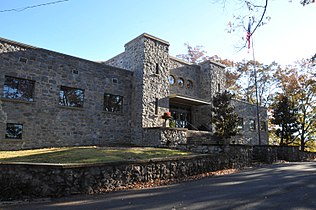
Alabama National Guard Armory, Guntersville, Alabama (1936)
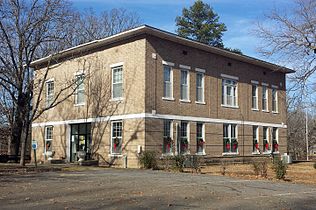
Prairie County Courthouse, DeValls Bluff, Arkansas (1939)

Griffith Observatory, Los Angeles, California (1933)
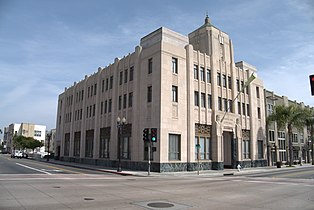
Santa Ana City Hall, Santa Ana, California (1935)
Leon High School, Tallahassee, Florida (1936–37)
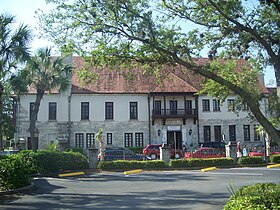
Government House, St. Augustine, Florida (1937)
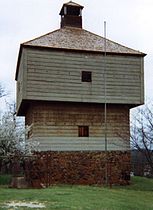
Fort Hawkins, Macon, Georgia (1936–38)
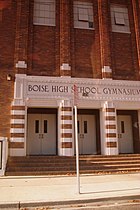
Boise High School Gymnasium, Boise, Idaho (1936)
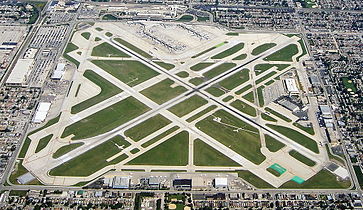
Midway International Airport, Chicago, Illinois (1935–39)
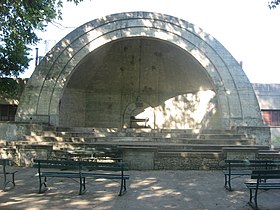
Gregg Park Bandshell, Vincennes, Indiana (1939)

Canoe house, University of Iowa (1937)
Jenkins Culvert, Gove County, Kansas (1938)
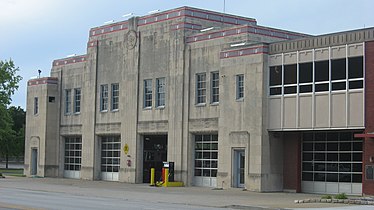
Louisville Fire Department Headquarters, Louisville, Kentucky (1936)

Alvar Street Branch, New Orleans Public Library (1940)

WPA Field House and Pump Station, Scituate, Massachusetts (1938)

Detroit Naval Armory, Detroit, Michigan (1936–39)

Brandon Auditorium and Fire Hall, Brandon, Minnesota (1936)
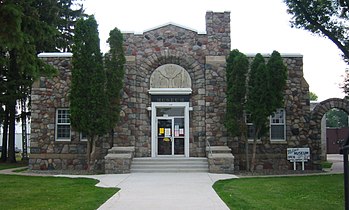
Milaca Municipal Hall, Milaca, Minnesota (1936)
Upland Auditorium, Upland, Nebraska (1936)
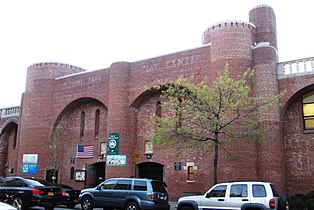
Jackie Robinson Play Center, Harlem, New York (1936)
LaGuardia Airport, Queens, New York (1937–39)

U.S. Post Office, Rhinebeck, New York (1940)
Robeson County Agricultural Building, Lumberton, North Carolina (1937)

Emmons County Courthouse, Linton, North Dakota (1934)
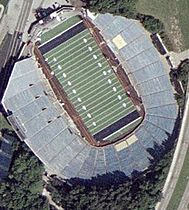
Rubber Bowl Stadium, Akron, Ohio (1940)

Timberline Lodge, Mt. Hood National Forest, Oregon (1936–38)
Oregon State Library, Salem, Oregon (1939)
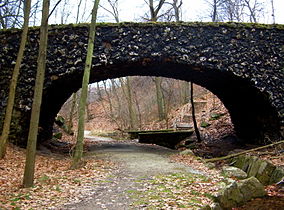
Schenley Park, Pittsburgh, Pennsylvania (1938–39)

McCoy Stadium, Pawtucket, Rhode Island (1942)

Dock Street Theatre, Charleston, South Carolina (1937)

Liberty Colored High School, Liberty, South Carolina (1937)
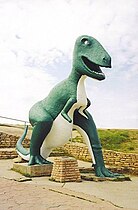
Dinosaur Park, Rapid City, South Dakota (1936)

Bristol Municipal Stadium, Bristol, Tennessee (1934)
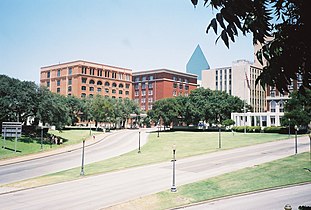
Dealey Plaza, Dallas, Texas (1940)
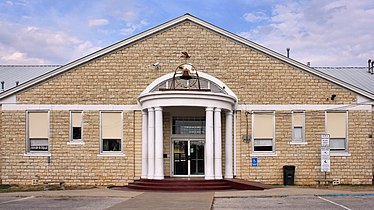
Schoolhouse, Lometa, Texas (1938–40)

River Walk, San Antonio, Texas (1939)

City Library, Monroe, Utah (1934)

Bremerton Public Library, Bremerton, Washington (1938)

White Center Fieldhouse, White Center, Washington (1938–40)

Raleigh County Courthouse, Beckley, West Virginia (1936–37)
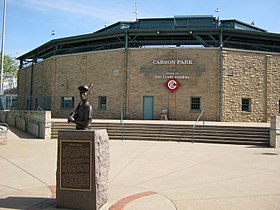
Carson Park Baseball Stadium, Eau Claire, Wisconsin (1937)
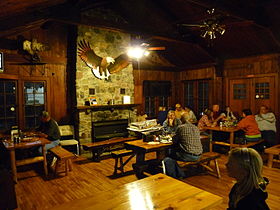
Mondeaux Lodge House, Westboro, Wisconsin (1936–38)
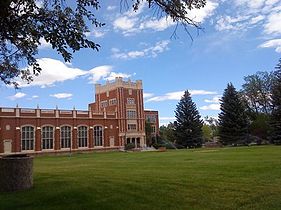
Natrona County High School, Casper, Wyoming (1941)
See also
- American Guide Series
- Federal Art Project
- Federal Project Number One
- Hatch Act of 1939
- List of Federal Art Project artists
- Presidency of Franklin D. Roosevelt
- Public Works of Art Project
Section of Painting and Sculpture, in Treasury department
References
^ ab Arnesen, Eric (2007). Encyclopedia of U.S. Labor and Working-Class History. 1. New York: Routledge. p. 1540. ISBN 9780415968263..mw-parser-output cite.citationfont-style:inherit.mw-parser-output qquotes:"""""""'""'".mw-parser-output code.cs1-codecolor:inherit;background:inherit;border:inherit;padding:inherit.mw-parser-output .cs1-lock-free abackground:url("//upload.wikimedia.org/wikipedia/commons/thumb/6/65/Lock-green.svg/9px-Lock-green.svg.png")no-repeat;background-position:right .1em center.mw-parser-output .cs1-lock-limited a,.mw-parser-output .cs1-lock-registration abackground:url("//upload.wikimedia.org/wikipedia/commons/thumb/d/d6/Lock-gray-alt-2.svg/9px-Lock-gray-alt-2.svg.png")no-repeat;background-position:right .1em center.mw-parser-output .cs1-lock-subscription abackground:url("//upload.wikimedia.org/wikipedia/commons/thumb/a/aa/Lock-red-alt-2.svg/9px-Lock-red-alt-2.svg.png")no-repeat;background-position:right .1em center.mw-parser-output .cs1-subscription,.mw-parser-output .cs1-registrationcolor:#555.mw-parser-output .cs1-subscription span,.mw-parser-output .cs1-registration spanborder-bottom:1px dotted;cursor:help.mw-parser-output .cs1-hidden-errordisplay:none;font-size:100%.mw-parser-output .cs1-visible-errorfont-size:100%.mw-parser-output .cs1-subscription,.mw-parser-output .cs1-registration,.mw-parser-output .cs1-formatfont-size:95%.mw-parser-output .cs1-kern-left,.mw-parser-output .cs1-kern-wl-leftpadding-left:0.2em.mw-parser-output .cs1-kern-right,.mw-parser-output .cs1-kern-wl-rightpadding-right:0.2em
^ Smith, Jason Scott (2006). Building New Deal Liberalism: The Political Economy of Public Works, 1933–1956. New York: Cambridge University Press. p. 87. ISBN 9780521828055.
^ "WPA Pays Up and Quits". The New York Times. July 1, 1943. Retrieved 2016-02-24.
^ Works Progress Administration (1936). "WPA Workers' Handbook". New Deal Network. Retrieved 2016-02-24.
^ ab Lee, Bradford A. (Spring 1982). "The New Deal Reconsidered". The Wilson Quarterly. 6 (2): 62–76. JSTOR 40256265.
^ abcdef Leighninger, Robert D. (2007). Long-Range Public Investment: The Forgotten Legacy of the New Deal. Columbia, S.C.: University of South Carolina Press. ISBN 9781570036637.
^ abcde Leighninger, Robert D. (May 1996). "Cultural Infrastructure: The Legacy of New Deal Public Space". Journal of Architectural Education. 49 (4): 226–236. JSTOR 1425295.
^ "Text of Relief Bill Offered in House". The New York Times. January 22, 1935. Retrieved 2016-02-27.
^ "Presidential Key Events, Franklin D. Roosevelt". Miller Center of Public Affairs, University of Virginia. Retrieved 2016-02-27.
^ "Records of the Work Projects Administration and Its Predecessors". Records of the Work Projects Administration (WPA). National Archives and Records Administration. Retrieved 2016-02-28.
^ Roosevelt, Franklin D. (May 6, 1935). "Executive Order 7034 – Creating Machinery for the Works Progress Administration". The American Presidency Project. Online by Gerhard Peters and John T. Woolley. Retrieved 2016-02-27.
^ Deeben, John P. (Fall 2012). "Family Experiences and New Deal Relief: The Correspondence Files of the Federal Emergency Relief Administration, 1933–1936". Prologue Magazine. Vol. 44 no. 2. National Archives and Records Administration. Retrieved 2016-02-27.
^ Flanagan, Hallie (1965). Arena: The History of the Federal Theatre. New York: Benjamin Blom, reprint edition [1940]. OCLC 855945294.
^ "Records of the Division of Engineering and Construction". Records of the Work Projects Administration (WPA). National Archives and Records Administration. Retrieved 2016-02-27.
^ "Records of the Division of Professional and Service Projects". Records of the Work Projects Administration (WPA). National Archives and Records Administration. Retrieved 2016-02-27.
^ "Records of the Division of Finance". Records of the Work Projects Administration (WPA). National Archives and Records Administration. Retrieved 2016-02-27.
^ "Records of the Division of Information". Records of the Work Projects Administration (WPA). National Archives and Records Administration. Retrieved 2016-02-27.
^ "Records of the Division of Investigation". Records of the Work Projects Administration (WPA). National Archives and Records Administration. Retrieved 2016-02-27.
^ "Records of the Division of Statistics". Records of the Work Projects Administration (WPA). National Archives and Records Administration. Retrieved 2016-02-27.
^ "Records of the Project Control Divisions". Records of the Work Projects Administration (WPA). National Archives and Records Administration. Retrieved 2016-02-27.
^ "Records of Other WPA Divisions". Records of the Work Projects Administration (WPA). National Archives and Records Administration. Retrieved 2016-02-27.
^ abcdefghij Taylor, Nick (2008). American-Made: The Enduring Legacy of the WPA, When FDR Put the Nation to Work. New York: Bantam Books. ISBN 9780553802351.
^ abcde Federal Reserve Bank of Minneapolis Community Development Project. "Consumer Price Index (estimate) 1800–". Federal Reserve Bank of Minneapolis. Retrieved January 2, 2018.
^ abcdefghi Howard, Donald S. (1973) [1943]. The WPA and Federal Relief Policy. New York: Da Capo Press. OCLC 255072517.
^ "WPA Employment." Gjenvick Archives: The Future of Our Past, Social and Cultural History. (2000)
^ "Records of WPA Projects". Records of the Work Projects Administration (WPA). National Archives and Records Administration. Retrieved 2016-02-25.
^
Kennedy, David M. (1999). Freedom from Fear: The American People in Depression and War, 1929–1945. New York: Oxford University Press. ISBN 9780195038347.
^ "Website on Merritt Parkway Bridges". Past-inc.org. Retrieved 2012-04-20.
^ "WPA and Rural Libraries". Newdeal.feri.org. Archived from the original on 1999-10-02. Retrieved 2012-04-20.
^ "Blazing the Way: The WPA Library Service Demonstration Project in South Carolina by Robert M. Gorman" (PDF). Archived from the original (PDF) on 2012-04-15. Retrieved 2012-04-20.
^ abcdefghij Adams, Don; Goldbard, Arlene (1995). "New Deal Cultural Programs: Experiments in Cultural Democracy". Webster's World of Cultural Democracy. Retrieved 2016-02-24.
^ abcdef Larson, Cedric (July 1939). "The Cultural Projects of the WPA". Public Opinion Quarterly. 3 (3): 491–496. JSTOR 2744973.
^ ab John Salmond, "The New Deal and the Negro" in John Braeman et al., eds. The New Deal: The National Level (1975). pp 188–89
^ Charles L. Lumpkins (2008). American Pogrom: The East St. Louis Race Riot and Black Politics. Ohio University Press. p. 179. ISBN 9780821418031.
^ Cheryl Lynn Greenberg (2009). To Ask for an Equal Chance: African Americans in the Great Depression. Rowman & Littlefield. p. 60. ISBN 9781442200517.
^ Anthony J. Badger (2011). New Deal / New South: An Anthony J. Badger Reader. U. of Arkansas Press. p. 38. ISBN 9781610752770.
^ Dickens, Bethany (November 18, 2014). "Episode 32 Tapestries". A History of Central Florida Podcast. Retrieved January 30, 2016.
^ "The Pack Horse Librarians of Eastern Kentucky". Horse Canada. Retrieved 2017-09-01.
^ Boyd, Donald C. (2007). "The Book Women of Kentucky: The WPA Pack Horse Library Project, 1936–1943". Libraries & the Cultural Record. 42 (2): 120 – via Project MUSE. (Subscription required (help)).
^ Alexander Keyssar, The right to vote: the contested history of democracy in the United States (2000) p 193
^ Gina Misiroglu, ed. (2015). American Countercultures: An Encyclopedia of Nonconformists, Alternative Lifestyles, and Radical Ideas in U.S. History. Routledge. p. 334. ISBN 9781317477297.CS1 maint: Extra text: authors list (link)
^ Ginzberg, Eli (2004) [1943]. The Unemployed. New Brunswick: Transaction Publishers. p. 447. ISBN 9780765805744.
^ Wood, Margaret Mary (1953). Paths of Loneliness: The Individual Isolated in Modern Society. New York: Columbia University Press. p. 61. OCLC 620533.
^ Report of investigation of public relief in the District of Columbia (U.S. Senate), (1938)
^ David A. Taylor, Soul of a people: the WPA Writer's Project uncovers Depression America (2009) p 12
^ Krugman, Paul (2007). The Conscience of a Liberal. New York: W. W. Norton & Company. p. 62. ISBN 9780393060690.
^ Roosevelt, Franklin D. (April 15, 1939). "Message to Congress on the Reorganization Act". The American Presidency Project. Online by Gerhard Peters and John T. Woolley. Retrieved 2015-06-29.
^ Roosevelt, Franklin D. "Fireside Chat 15: On National Defense (May 26, 1940)". Miller Center of Public Affairs, University of Virginia. Retrieved 2016-02-25.
^ Associated Press (October 1, 1940). "WPA Head Dies in Connecticut". Chicago Tribune. Retrieved 2016-02-25.
^ ab Roosevelt, Franklin D. (December 4, 1942). "Letter to the Federal Works Administrator Discontinuing the W.P.A." The American Presidency Project. Online by Gerhard Peters and John T. Woolley. Retrieved 2015-06-23.
Further reading
- Adams, Don; Goldbard, Arlene. "New Deal Cultural Programs: Experiments in Cultural Democracy." Webster's World of Cultural Democracy 1995.
- Halfmann, Drew, and Edwin Amenta. "Who voted with Hopkins? Institutional politics and the WPA." Journal of Policy History 13#2 (2001): 251–287. online
- Hopkins, June. "The Road Not Taken: Harry Hopkins and New Deal Work Relief" Presidential Studies Quarterly 29#2 (1999): 306–16 online
- Howard, Donald S. WPA and federal relief policy (1943), 880pp; highly detailed report by the independent Russell Sage Foundation.
- Kelly, Andrew, Kentucky by Design: The Decorative Arts, American Culture and the Arts Programs of the WPA. Lexington: University Press of Kentucky. 2015.
- Larson, Cedric. "The Cultural Projects of the WPA." The Public Opinion Quarterly 3#3 (1939): 491–196. Accessed in JSTOR
- Leighninger, Robert D. "Cultural Infrastructure: The Legacy of New Deal Public Space." Journal of Architectural Education 49, no. 4 (1996): 226–236.
- Leighninger, Robert D., Jr. Long-Range Public Investment: the Forgotten Legacy of the New Deal. Columbia, S.C.: University of South Carolina Press (2007).
- Lindley, Betty Grimes & Lindley, Ernest K. A New Deal for Youth: the Story of the National Youth Administration (1938)
- McJimsey George T. Harry Hopkins: Ally of the Poor and Defender of Democracy (1987)
- Meriam; Lewis. Relief and Social Security. 900 pp. Washington, DC: The Brookings Institution, 1946.
- Millett; John D. & Gladys Ogden. Administration of Federal Work Relief 1941.
- Musher, Sharon Ann. Democratic Art: The New Deal's Influence on American Culture. Chicago: University of Chicago Press, 2015.
- Rose, Nancy. The WPA and Public Employment in the Great Depression (2009)
- Sargent, James E. "Woodrum's Economy Bloc: The Attack on Roosevelt's WPA, 1937–1939." Virginia Magazine of History and Biography (1985): 175–207. in JSTOR
- Sheppard, Si. Buying of the Presidency?, The: Franklin D. Roosevelt, the New Deal, and the Election of 1936 (ABC-CLIO, 2014).
- Singleton, Jeff. The American Dole: Unemployment Relief and the Welfare State in the Great Depression (2000)
- Smith, Jason Scott. Building New Deal Liberalism: the Political Economy of Public Works, 1933–1956 (2005)
- Taylor, David A. Soul of a People: The WPA Writers' Project Uncovers Depression America. (2009)
- Taylor, Nick. American-Made: The Enduring Legacy of the WPA: When FDR Put the Nation to Work (2008)
- United States Senate. "Report of investigation of public relief in the District of Columbia". Washington D.C.: 1938
- Williams, Edward Ainsworth. Federal aid for relief (1939)
- Young, William H., & Nancy K. The Great Depression in America: a Cultural Encyclopedia. 2 vols. Westport, Conn.: Greenwood Press, 2007
ISBN 0-313-33520-6
External links
| Wikimedia Commons has media related to Works Progress Administration. |
Wikisource has original text related to this article: Executive Order 7034 |
John C. Kennedy Papers. 1912–1938. 5" linear (circa 80 items).
Footage of the Federal Theatre Project's 1936 "Voodoo Macbeth" – with informative annotations.
The Great Depression in Washington State Project, including an illustrated map of major WPA projects and a multimedia history of the Federal Theater Project in the State.- The Index of American Design at the National Gallery of Art
Works by Work Projects Administration at Project Gutenberg
Works by or about Works Progress Administration at Internet Archive
Works by Works Progress Administration at LibriVox (public domain audiobooks)
- Guide to the WPA Oregon Federal Art Project collection at the University of Oregon
- WPA inspired Gulf Coast Civic Works Project
An Introduction to the Employer of Last Resort Proposal from Dollars & Sense. Includes several images from the original WPA.
Living New Deal Project – The Living New Deal Project documents the living legacy of New Deal agencies, including the WPA. The Living New Deal website includes an extensive digital map featuring detailed information about specific WPA projects by location.- New Deal Agencies: The Works Progress Administration
Soul of a People documentary on Smithsonian Networks
Works Progress Administration Tampa Office Records at the University of South Florida
Arizona Archives Online Finding Aid – The Arizona State Museum Library & Archives holds the records of the WPA Statewide Archaeological Project (1938–1940) and are found on AAO.
WPA Art Inventory Project at the Connecticut State Library
WPA Omaha, Nebraska City Guide Project by the University of Nebraska Omaha Dr. C.C. and Mabel L. Criss Library.- WPA publications from Alabama, Florida, Georgia, Kentucky, Louisiana, Maryland, North Carolina, and Tennessee housed at the University of Kentucky Libraries Special Collections Research Center
Tapestries at A History of Central Florida Podcast
WPA digital collection at the New York Public Library
WPA Music Manuscripts at Wayne State University Library is a digitization project that contains 174 images of WPA music copies from 1935–1943.
WPA posters:
- Posters from the WPA at the Library of Congress
Libraries and the WPA:
- The WPA Library Project in South Carolina
- South Carolina Public Library History, 1930–1945
WPA Children’s Books (1935–1943) Broward County Library's Bienes Museum of the Modern Book
WPA murals:
- Database of WPA murals
- WPA-FAP Mural Division in NYC, and restoration of murals at the Williamsburg Houses and Hospital for Chronic Diseases on Welfare Island
WPA mural projects by noted muralist Sr. Lucia Wiley- WPA Artist Louis Schanker
- WPA Artist Robert Tabor

































